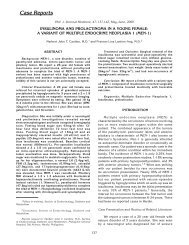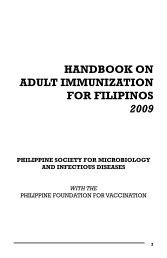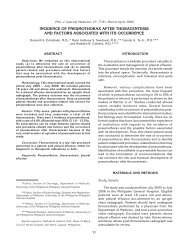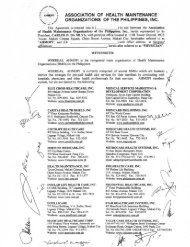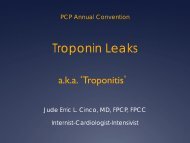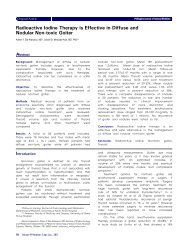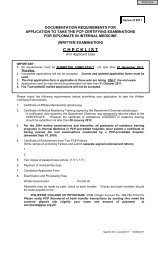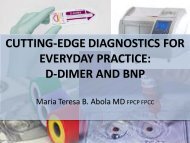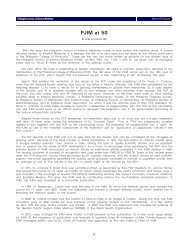Septic Shock by Dr Ruth M Divinagracia - Philippine College of ...
Septic Shock by Dr Ruth M Divinagracia - Philippine College of ...
Septic Shock by Dr Ruth M Divinagracia - Philippine College of ...
- No tags were found...
You also want an ePaper? Increase the reach of your titles
YUMPU automatically turns print PDFs into web optimized ePapers that Google loves.
What To Do Before TheSubspecialist Arrives: <strong>Septic</strong><strong>Shock</strong><strong>Ruth</strong> M. <strong>Divinagracia</strong>, M.D.Clinical Associate Pr<strong>of</strong>essor<strong>College</strong> <strong>of</strong> Medicine and <strong>Philippine</strong> General HospitalUniversity <strong>of</strong> the <strong>Philippine</strong>sAttending PhysicianMakati Medical CenterSaint Luke’s Medical Center Global CityRD 5/12
<strong>Septic</strong> <strong>Shock</strong>• Acute organ dysfunction secondary to infection(sepsis) associated with hypotension notreversed <strong>by</strong> fluid resuscitation• Severe sepsis accounts for 9.3% <strong>of</strong> all deaths inthe US (Angus et al Crit Care Med 2001: 29)• <strong>Septic</strong> shock, the most severe manifestation <strong>of</strong>sepsis, occurs in 2 to 20% <strong>of</strong> inpatients (Matot et alInt Care Med 2001:27)• Overall mortality for severe sepsis is 30% and50% for septic shock (Annane et AJRCCM 2003:168)and kills approximately 1400 people worldwidedailyRD 5/12
Epidemiology <strong>of</strong>Sepsis in the US<strong>Septic</strong>shock(severe sepsisplus refractoryhypotension)200,000 casesCrudemortality45%Number <strong>of</strong>deaths annually90,000Severe sepsis(sepsis plus organ failure)300,000 cases20%60,000Sepsis(systemic inflammatory response syndromeplus evidence <strong>of</strong> infection)400,000 cases15%60,000NEJM 2002; 347:966-67Total: 210,000RD 5/12
Sepsis and <strong>Septic</strong> <strong>Shock</strong> DefinedSEPSIS• (+) infection (proven <strong>of</strong> suspected) plus thepresence <strong>of</strong> SIRS (on the basis <strong>of</strong> ≥ 2 <strong>of</strong> thefollowing):• Increased HR > 90/min• Increased RR > 20 or PaCO2 less than 32or use <strong>of</strong> MV• Increased temperature > 38C or decreasedtemperature < 36C• Increased WBC (>12,000) or decreasedWBC (90% immature forms• Hyperglycemia, elevated CRP and procalcitoninLevy et al Crit Care Med 2003;31:1250-56RD 5/12
Supplemental oxygen endotrachealintubation and mechanical ventilationCentral venous and arterial catherizationSedation, paralysis(if intubated), or bothInitial Fluid Resuscitation:The Rivers Protocol8-12 mmHgCVP< 8 mmHgCrystalloidColloid< 65 mmHgMAP> 90 mmHg> 65 and < 90 mmHg< 70%ScvO 2Vasoactive agentsTransfusion <strong>of</strong> red cellsuntil hematocrit > 30%Inotropic agents> 70%< 70%NoYesGoalsachievedScvO 2Hospital admissionRivers et al NEJM 2001;345:1368-77)RD 5/12
Kaplan- Meier Estimates <strong>of</strong> Mortality and Causes<strong>of</strong> In-Hospital Death: Early Goal - Directed TherapyTable 3. Kaplan-Meier Estimate's <strong>of</strong> Mortality and Causes <strong>of</strong> Hospital Death*VariableIn-hospital mortalityAll patientsPatients with severe sepsisPatients with septic shockPatients with sepsis syndromeStandardTherapy59 (46.5)19 (30.0)40 (56.8)44 (45.4)No. (%)EarlyGoal-DirectedTherapy(N = 130)38 (30.5)9 (14.9)29 (42.3)35 (35.1)Relative Risk(95% Cl)0.58 (0.38-0.87)0.46 (0.21-1.03)0.60 (0.36-0.98)0.66 (0.42-1.04)P Value0.0090.060.040.0728-day mortality 61 (49.2) 40 (33.3) 0.58 (0.39-0.87) 0.0160-day mortality 70 (56.9) 50 (44.3) 0.67 (0.46-0.96) 0.03Causes <strong>of</strong> in-hospital deathSudden cardiovascular collapseMulti-organ failure25/199 (21.0)26/119 (21.8)12/17 (10.3)19/117 (16.2)----0.020.27Rivers et al NEJM 2001;345:1368-77)RD 5/12
Inotropic Therapy/Bicarbonate• Use dobutamine in patients with myocardialdysfunction as supported <strong>by</strong> elevatedcardiac filling pressures and low cardiacoutputTherapy• Do NOT increased cardiac index to predeterminedSUPRANORMAL levels• Bicarbonate should NOT be used hypoperfusioninducedlactic acidosisDellinger et al Surviving Sepsis Campaign: Crit Care Med2008; 36: 296-327RD 5/12
Steroids for <strong>Septic</strong> <strong>Shock</strong>? : Rationalefor Physiologic Dose• Relative adrenal insufficiency may be present in up to50% <strong>of</strong> patients with septic shock( Annane et al 2000: 283)• Systemic inflammation may lead to glucocorticoidreceptor resistance (Molijn et al J Clin Endocrinol Metab 1995; 80)• Patients with septic shock who had a reducedresponse to corticotropin (increase in plasmacortisol < 9 µg per deciliter) were likely to die(Rothwell et al Lancet 1991: 337)RD 5/12
CORTICUS Study: Placebo vsSteroids in <strong>Septic</strong> <strong>Shock</strong>Kaplan-Meier Curve for The Time to Reversal <strong>of</strong> <strong>Shock</strong>Sprung et al NEJM 2008; 358: 111-124RD 5/12
Probability <strong>of</strong> Survival and being DischargedHome after Randomization: Low Tidal Volume vsTraditional Tidal VolumeThe ARDS Network NEJM 2000; 342: 1301-1308RD 5/12
Low Tidal Volume Ventilation Strategy inPatients with ARDSMortality Among Patients with Pulmonary versus Nonpulmonary RiskFactors for ALI/ARDS: Efficacy <strong>of</strong> the Low VT Ventilation StrategyClinical riskfactorLow V T Ventilation*6 ml/kg (n = 473)Traditional V TVentilation 12 ml/kg (n= 429)All Patients †(n = 902)Pulmonary 32%76 / 23440%89 / 22036%165 / 454Nonpulmonary29%70 / 23940%84 / 20934%154 / 448Eisner et al AJRCCM 2001RD 5/12
Management <strong>of</strong> Patients with ARDS• Ventilate with “ lung protective strategy” – VT <strong>of</strong> 6 ml/kg,Pplat target <strong>of</strong> ≤ 30 cm H20, non-toxic FiO2 with more modestPaO2 goal <strong>of</strong> pO2 <strong>of</strong> at least 55 mm Hg or SpO2 <strong>of</strong> at least88%• Use <strong>of</strong> PEEP to improvement recruitment, to preventalveolar trauma and to decrease FiO2 requirement• Use <strong>of</strong> CVC (instead <strong>of</strong> PAC)• “Conservative” fluid management strategy (keep patient onthe “dry” side!) in patients who have no evidence <strong>of</strong> tissuehypoperfusion after initial fluid resuscitationARDSnet Publications, 2000, 2005RD 5/12
<strong>Septic</strong> <strong>Shock</strong>: The Critical First 6 Hours• Appropriate and prompt diagnosis <strong>of</strong> severesepsis and septic shock• Early-Goal Directed Therapy (1C)• Blood Cultures before antibiotic therapy, othercultures as needed (1C)• Administration <strong>of</strong> antibiotics within 1 hour <strong>of</strong>diagnosis <strong>of</strong> septic shock (1B)• Vasopressor preference for norepinephrine anddopamine (1C)• Low tidal volume, limitation <strong>of</strong> plateau pressureand the use <strong>of</strong> PEEP in ALI/ARDS (1B)• Use <strong>of</strong> stress dose steroids with hydrocortisoneas choice should be considered (2C)RD 5/12
RD 5/12



